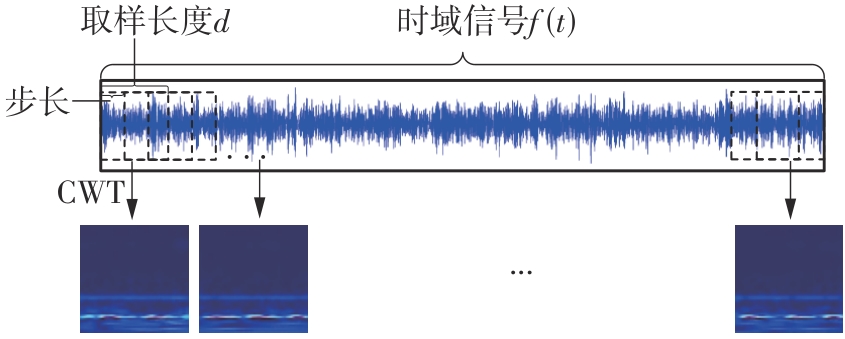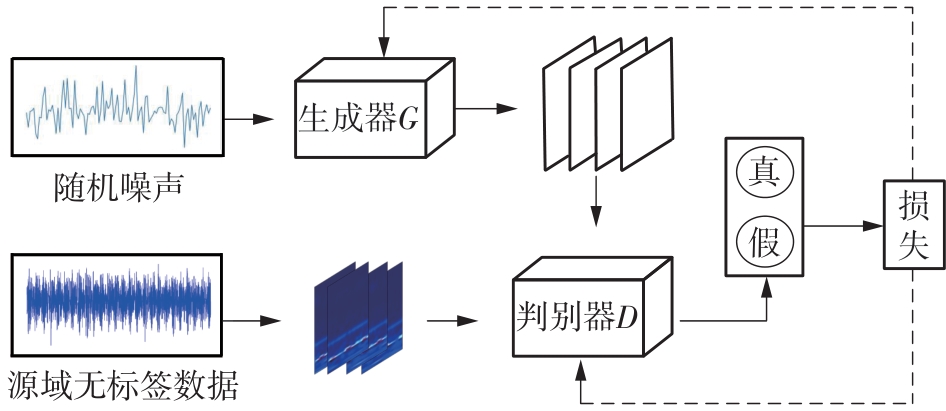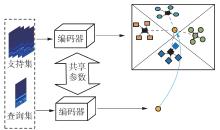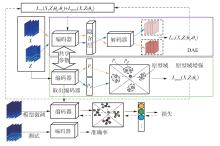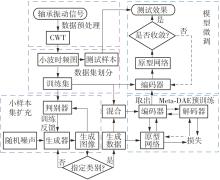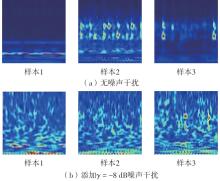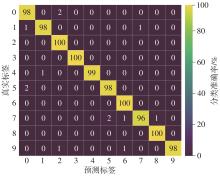Journal of South China University of Technology(Natural Science Edition) ›› 2025, Vol. 53 ›› Issue (1): 62-73.doi: 10.12141/j.issn.1000-565X.230715
• Electronics, Communication & Automation Technology • Previous Articles Next Articles
Meta-DAE Fault Diagnosis Based on Prototype Domain Enhancement in Few-Shot
MA Ping LIANG Cheng WANG Cong LI Xinkai ZHANG Hongli
- School of Electrical Engineering,Xinjiang University,Urumqi 830017,Xinjiang,China
-
Received:2023-11-16Online:2025-01-25Published:2025-01-02 -
Contact:梁城(1998—),男,硕士,主要从事模式识别和智能故障诊断研究。 E-mail:lcss5545@163.com -
About author:马萍(1994—),女,博士,副教授,主要从事机械系统动态建模与信号处理、智能故障诊断与寿命预测研究。E-mail: maping@xju.edu.cn -
Supported by:the National Natural Science Foundation of China(52065064)
CLC Number:
Cite this article
MA Ping, LIANG Cheng, WANG Cong, et al. Meta-DAE Fault Diagnosis Based on Prototype Domain Enhancement in Few-Shot[J]. Journal of South China University of Technology(Natural Science Edition), 2025, 53(1): 62-73.
share this article
Table 1
DCGAN structure parameters"
| 模型 | 网络层 | 操作 | 激活函数 |
|---|---|---|---|
| 生成器 | Input(1,100) | ||
| T-Conv2d(100,512) | BN | ReLU | |
| T-Conv2d(512,256) | BN | ReLU | |
| T-Conv2d(256,128) | BN | ReLU | |
| T-Conv2d(128,64) | BN | ReLU | |
| T-Conv2d(64,3) | BN | ReLU | |
| 判别器 | Conv2d(3,64) | LeakyReLU | |
| Conv2d(64,128) | BN | LeakyReLU | |
| Conv2d(128,256) | BN | LeakyReLU | |
| Conv2d(256,512) | BN | LeakyReLU | |
| Conv2d(512,1) | Sigmoid |
Table 2
Meta-DAE network architecture"
| 模型 | 网络层 | 操作 | 激活函数 |
|---|---|---|---|
| 编码器 | Conv2d(3,32) | BN | |
| Conv2d(32,64) | BN Maxpool | ReLU | |
| Conv2d(64,64) | BN | ReLU | |
| Conv2d(64,64) | BN | ReLU | |
| Conv2d(64,128) | BN | ReLU | |
| Conv2d(128,128) | BN Maxpool | ReLU | |
| 解码器 | T-Conv2d(128,128) | BN | ReLU |
| T-Conv2d(128,64) | BN | ReLU | |
| T-Conv2d(64,64) | BN | ReLU | |
| T-Conv2d(64,32) | BN | ReLU | |
| T-Conv2d(32,16) | BN | ReLU | |
| T-Conv2d(16,3) | Sigmoid |
Table 4
Division of CWRU rolling bearing dataset under four different working conditions"
| 工况 | 数据集 | 样本数 | |||||||||
|---|---|---|---|---|---|---|---|---|---|---|---|
| NC | IF-7 | IF-14 | IF-21 | OF-7 | OF-14 | OF-21 | RF-7 | RF-14 | RF-21 | ||
| A | 训练集 | 90 | 90 | 90 | 90 | 90 | 90 | 90 | 90 | 90 | 90 |
| 测试数 | 210 | 210 | 210 | 210 | 210 | 210 | 210 | 210 | 210 | 210 | |
| B | 训练集 | 90 | 90 | 90 | 90 | 90 | 90 | 90 | 90 | 90 | 90 |
| 测试集 | 210 | 210 | 210 | 210 | 210 | 210 | 210 | 210 | 210 | 210 | |
| C | 训练集 | 90 | 90 | 90 | 90 | 90 | 90 | 90 | 90 | 90 | 90 |
| 测试集 | 210 | 210 | 210 | 210 | 210 | 210 | 210 | 210 | 210 | 210 | |
| D | 训练集 | 90 | 90 | 90 | 90 | 90 | 90 | 90 | 90 | 90 | 90 |
| 测试集 | 210 | 210 | 210 | 210 | 210 | 210 | 210 | 210 | 210 | 210 | |
Table 5
Classification accuracy of Meta-DAE model under different prototype domain enhancement factors"
| 10类-1样本划分策略下的分类准确率/% | 10类-5样本划分策略下的分类准确率/% | |||||
|---|---|---|---|---|---|---|
| 样本数为10 | 样本数为20 | 样本数为30 | 样本数为10 | 样本数为20 | 样本数为30 | |
| 0.0 | 94.56 | 98.82 | 99.30 | 97.56 | 99.16 | 99.56 |
| 0.2 | 97.25 | 99.25 | 99.73 | 98.86 | 99.31 | 99.76 |
| 0.4 | 98.67 | 99.55 | 99.76 | 99.16 | 99.37 | 99.89 |
| 0.6 | 99.16 | 99.67 | 99.83 | 99.64 | 99.87 | 99.98 |
| 0.8 | 99.12 | 99.42 | 99.86 | 99.38 | 99.64 | 99.92 |
| 1.0 | 98.07 | 99.25 | 99.68 | 99.12 | 99.52 | 99.86 |
Table 6
Classification accuracy of six models under different noise interferences on CWRU rolling bearing dataset"
| 样本数 | 模型 | 分类准确率/% | |||
|---|---|---|---|---|---|
| 无噪声 | 噪声γ = 0 dB | 噪声γ = -4 dB | 噪声γ = -8 dB | ||
| 10 | ResNet | 90.79 | 71.78 | 58.79 | 39.87 |
| LeNet | 89.43 | 79.11 | 62.89 | 23.22 | |
| ProtoNet | 97.67 | 74.40 | 65.42 | 38.95 | |
| LeNet-ProtNet | 93.36 | 48.26 | 41.80 | 22.20 | |
| ResNet-ProtoNet | 96.20 | 72.14 | 35.40 | 18.40 | |
| Meta-DAE | 99.66 | 88.67 | 74.25 | 75.65 | |
| 20 | ResNet | 96.62 | 81.86 | 70.36 | 48.38 |
| LeNet | 94.36 | 81.75 | 67.13 | 41.25 | |
| ProtoNet | 98.92 | 82.36 | 68.22 | 45.11 | |
| LeNet-ProtNet | 96.54 | 62.20 | 65.33 | 21.80 | |
| ResNet-ProtoNet | 98.89 | 84.42 | 63.00 | 20.60 | |
| Meta-DAE | 99.87 | 92.60 | 81.50 | 83.16 | |
| 30 | ResNet | 98.56 | 85.21 | 74.39 | 58.42 |
| LeNet | 97.58 | 84.79 | 72.78 | 46.33 | |
| ProtoNet | 99.42 | 85.82 | 71.34 | 56.78 | |
| LeNet-ProtNet | 98.72 | 71.45 | 69.26 | 26.13 | |
| ResNet-ProtoNet | 99.64 | 87.52 | 68.93 | 24.32 | |
| Meta-DAE | 99.98 | 93.25 | 82.45 | 85.67 | |
Table 7
Classification accuracy of different models under cross domain conditions"
| 样本数 | 模型 | 不同跨域工况下的分类准确率/% | |||||
|---|---|---|---|---|---|---|---|
| A→B | B→C | C→D | D→A | A→C | A→D | ||
| 10 | LeNet | 87.12 | 87.42 | 86.69 | 67.83 | 84.67 | 62.23 |
| ResNet | 84.34 | 85.73 | 84.22 | 69.35 | 78.86 | 66.23 | |
| ProtoNet | 95.23 | 95.48 | 95.41 | 90.14 | 94.60 | 94.41 | |
| LeNet-ProtoNet | 92.72 | 93.66 | 92.83 | 85.31 | 92.52 | 86.81 | |
| ResNet-ProtoNet | 94.28 | 94.57 | 94.26 | 92.89 | 95.04 | 94.36 | |
| Meta-DAE | 99.13 | 99.32 | 99.45 | 97.56 | 99.23 | 98.67 | |
| 20 | LeNet | 88.29 | 89.58 | 89.95 | 64.16 | 85.24 | 66.34 |
| ResNet | 89.46 | 93.15 | 90.72 | 75.14 | 82.67 | 74.93 | |
| ProtoNet | 98.76 | 97.74 | 98.06 | 96.23 | 98.86 | 97.12 | |
| LeNet-ProtoNet | 93.52 | 94.07 | 94.50 | 86.78 | 94.68 | 88.32 | |
| ResNet-ProtoNet | 97.18 | 97.29 | 97.12 | 96.48 | 98.65 | 97.52 | |
| Meta-DAE | 99.61 | 99.76 | 99.67 | 98.23 | 99.78 | 99.25 | |
| 30 | LeNet | 92.72 | 93.78 | 90.59 | 72.95 | 91.32 | 73.62 |
| ResNet | 93.67 | 96.47 | 97.35 | 79.81 | 85.34 | 81.52 | |
| ProtoNet | 98.94 | 98.92 | 98.85 | 97.65 | 98.36 | 98.82 | |
| LeNet-ProtoNet | 96.64 | 96.95 | 95.71 | 92.54 | 96.56 | 93.84 | |
| ResNet-ProtoNet | 98.54 | 98.86 | 98.77 | 97.23 | 99.23 | 98.79 | |
| Meta-DAE | 99.82 | 99.93 | 99.84 | 99.44 | 99.98 | 99.73 | |
Table 9
Classification accuracy of six models under different noise interferences on the bearing dataset of Xinjiang University"
| 模型 | 分类准确率/% | |||
|---|---|---|---|---|
| 无噪声 | 噪声γ= 0 dB | 噪声γ= -4 dB | 噪声γ= -8 dB | |
| LeNet | 85.30 | 69.78 | 58.96 | 29.87 |
| ResNet | 90.15 | 72.74 | 62.96 | 37.07 |
| ProtoNet | 92.53 | 70.27 | 63.33 | 40.20 |
| LeNet-ProtoNet | 81.46 | 52.48 | 41.35 | 25.62 |
| ResNetrotoNet | 84.78 | 55.44 | 43.72 | 28.28 |
| Meta-DAE | 98.96 | 88.07 | 82.81 | 75.36 |
Table 10
Description of the bearing dataset of Southeast University"
| 工况 | 轴承故 障位置 | 齿轮故 障类型 | 样本数 | 标签 | |
|---|---|---|---|---|---|
| 训练集 | 测试集 | ||||
| 20 Hz-0 V | 滚动体 | 齿轮裂纹 | 90 | 210 | 0 |
| 20 Hz-0 V | 内圈、外圈 | 健康 | 90 | 210 | 1 |
| 20 Hz-0 V | 健康 | 缺齿故障 | 90 | 210 | 2 |
| 20 Hz-0 V | 内圈 | 齿根断裂 | 90 | 210 | 3 |
| 20 Hz-0 V | 外圈 | 齿面磨损 | 90 | 210 | 4 |
| 30 Hz-2 V | 滚动体 | 齿轮裂纹 | 90 | 210 | 5 |
| 30 Hz-2 V | 内圈、外圈 | 健康 | 90 | 210 | 6 |
| 30 Hz-2 V | 健康 | 缺齿故障 | 90 | 210 | 7 |
| 30 Hz-2 V | 内圈 | 齿根断裂 | 90 | 210 | 8 |
| 30 Hz-2 V | 外圈 | 齿面磨损 | 90 | 210 | 9 |
Table 11
Classification accuracy of six models under different noise interferences on the bearing dataset of Southeast University"
| 数据集 | 模型 | 分类准确率/% | |||
|---|---|---|---|---|---|
| 无噪声 | 噪声γ=0 dB | 噪声γ= -4 dB | 噪声γ= -8 dB | ||
| 轴承 | LeNet | 82.52 | 49.89 | 31.78 | 15.67 |
| ResNet | 81.13 | 44.44 | 27.56 | 17.11 | |
| ProtoNet | 83.32 | 51.67 | 33.22 | 24.44 | |
| LeNet-ProtoNet | 65.96 | 35.72 | 27.80 | 15.12 | |
| ResNet-ProtoNet | 72.14 | 32.20 | 21.48 | 12.16 | |
| Meta-DAE | 97.64 | 85.36 | 81.24 | 74.83 | |
| 齿轮 | LeNet | 76.63 | 36.79 | 21.89 | 12.11 |
| ResNet | 79.36 | 35.11 | 26.62 | 13.36 | |
| ProtoNet | 82.31 | 45.24 | 22.47 | 12.83 | |
| LeNet-ProtoNet | 62.94 | 29.04 | 19.48 | 14.56 | |
| ResNet-ProtoNet | 83.76 | 28.52 | 21.37 | 16.78 | |
| Meta-DAE | 96.26 | 83.75 | 78.63 | 72.51 | |
| 1 | HU X S, ZHANG K, LIU K L,et al .Advanced fault diagnosis for lithium-ion battery systems:a review of fault mechanisms,fault features,and diagnosis procedures[J].IEEE Industrial Electronics Magazine,2020,14(3):65-91. |
| 2 | KANKAR P K, SHARMA S C, HARSHA S P .Fault diagnosis of ball bearings using machine learning methods[J].Expert Systems with Applications,2011,38(3):1876-1886. |
| 3 | LEI Y G, YANG B, JIANG X W,et al .Applications of machine learning to machine fault diagnosis:a review and roadmap[J].Mechanical Systems and Signal Processing,2020,138:106587/1-39. |
| 4 | FENG Y, CHEN J L, XIE J S,et al .Meta-learning as a promising approach for few-shot cross-domain fault diagnosis:algorithms,applications,and prospects[J].Knowledge-Based Systems,2022,235:107646/1-27. |
| 5 | HOANG D T, KANG J .A survey on deep learning based bearing fault diagnosis[J].Neurocomputing,2019,335:327-335. |
| 6 | JIA F, LEI Y, GUO L,et al .A neural network constructed by deep learning technique and its application to intelligent fault diagnosis of machines[J].Neurocomputing,2018,272:619-628. |
| 7 | WEN L, LI X Y, GAO L,et al .A new convolutional neural network-based data-driven fault diagnosis method[J].IEEE Transactions on Industrial Electronics,2017,65(7):5990-5998. |
| 8 | ZHANG W, PENF G L, LI C H,et al .A new deep learning model for fault diagnosis with good anti-noise and domain adaptation ability on raw vibration signals[J].Sensors,2017,17(2):425/1-21. |
| 9 | ZHAO M H, ZHONG S S, FU X Y,et al .Deep residual shrinkage networks for fault diagnosis[J].IEEE Transactions on Industrial Informatics,2019,16(7):4681-4690. |
| 10 | 万若青,张纯,江汇强,等 .基于深度自编码器的振动信号盲去噪方法[J].振动与冲击,2023,42(12):118-125. |
| WAN Ruoqing, ZHANG Chun, JIANG Huiqiang,et al .A blind denoising method of vibration signals based on a deep autoencoder[J].Journal of Vibration and Shock,2023,42(12):118-125. | |
| 11 | DONG Y J, LI Y Q, ZHENG H L,et al .A new dynamic model and transfer learning based intelligent fault diagnosis framework for rolling element bearings race faults:solving the small sample problem[J].ISA Transactions,2022,121:327-348. |
| 12 | 刘飞,陈仁文,邢凯玲,等 .基于迁移学习与深度残差网络的滚动轴承快速故障诊断算法[J].振动与冲击,2022,41(3):154-164. |
| LIU Fei, CHEN Renwen, XING Kailing,et al .Fast fault diagnosis algorithm for rolling bearings based on transfer learning and deep residual network[J].Journal of Vibration and Shock,2022,41(3):154-164. | |
| 13 | CHEN H, LIU R N, XIE Z X,et al .Majorities help minorities:hierarchical structure guided transfer lear-ning for few-shot fault recognition[J].Pattern Recognition,2022,123:108383/1-15. |
| 14 | ZHANG T C, CHEN J L, HE S L,et al .Prior knowledge-augmented self-supervised feature learning for few-shot intelligent fault diagnosis of machines[J].IEEE Transactions on Industrial Electronics,2022,69(10):10573-10584. |
| 15 | 强睿儒,赵小强 .基于格拉姆角差场和生成对抗网络的小样本滚动轴承故障诊断方法[J].华南理工大学学报(自然科学版),2024,52(10):64-75. |
| QIANG Ruiru, ZHAO Xiaoqiang.Fault diagnosis method for rolling bearings based on Gram angular field and generative adversarial networks[J].Journal of South China University of Tchnology(Natural Science Edition),2024,52(10):64-75. | |
| 16 | 胡若晖,张敏,许文鑫 .基于DCGAN和DANN网络的滚动轴承跨域故障诊断[J].振动与冲击,2022,41(6):21-29. |
| HU Ruohui, ZHANG Min, XU Wenxin .Cross-domain fault diagnosis of rolling element bearings using DCGAN and DANN[J].Journal of Vibration and Shock,2022,41(6):21-29. | |
| 17 | LEI T Y, HU H H, LUO Q Y,et al .Adaptive meta-learner via gradient similarity for few-shot text classification[EB/OL].(2022-09-10)[2023-06-20].. |
| 18 | CHEN Y D, GUAN C Y, WEI Z K,et al .Meta-Delta:a meta-learning system for few-shot image cla-ssification[J].Proceedings of Machine Learning Research,2021,140:17-28. |
| 19 | HOSPEDALES T, ANTREAS A, MICAELL P,et al .Meta-learning in neural networks:a survey[J].IEEE Transactions on Pattern Analysis and Machine Intelligence,2021,44(9):5149-5169. |
| 20 | LI C J, LI S B, ZHANG A S,et al .Meta-learning for few-shot bearing fault diagnosis under complex working conditions[J].Neurocomputing,2021,439:197-211. |
| 21 | WANG D, ZHANG M, XU Y C,et al .Metric-based meta-learning model for few-shot fault diagnosis under multiple limited data conditions[J].Mechanical Systems and Signal Processing,2021,155:107510/1-15. |
| 22 | FENG Y, CHEN J L, ZHANG T C,et al .Semi-supervised meta-learning networks with squeeze-and-excitation attention for few-shot fault diagnosis[J].ISA Transactions,2022,120:383-401. |
| 23 | YAN R Q, GAO R X, CHEN X F .Wavelets for fault diagnosis of rotary machines:a review with applications [J].Signal Processing,2014,96:1-15. |
| 24 | RADFORD A, METZ L, CHINTALA S .Unsupervised representation learning with deep convolutional generative adversarial networks[EB/OL].(2015-11-19)[2023-06-20].. |
| 25 | SNELL J, SWERSKY K, ZEMEL R .Prototypical networks for few-shot learning[C]∥ Proceedings of the 31st International Conference on Neural Information Processing Systems.Long Beach:ACM,2017:4080-4090. |
| 26 | SAUFI S R, AHMAD Z A B, LEONG M S,et al .Gearbox fault diagnosis using a deep learning model with limited data sample[J].IEEE Transactions on Industrial Informatics,2020,16(10):6263-6271. |
| [1] | QIANG Ruiru, ZHAO Xiaoqiang. A Small Sample Rolling Bearing Fault Diagnosis Method Based on Gramian Angular Difference Field and Generative Adversarial Network [J]. Journal of South China University of Technology(Natural Science Edition), 2024, 52(10): 64-75. |
| [2] | CHEN Xindu, FU Zhisen, WU Zhiheng, et al.. Small-Sample Fault Diagnosis Method Based on Multi-Head Convolution and Differential Self-Attention [J]. Journal of South China University of Technology(Natural Science Edition), 2023, 51(7): 21-33. |
| [3] | ZHAO Rongchao, WU Baili, CHEN Zhuyun, et al. Graph Neural Network for Fault Diagnosis with Multi-Scale Time-Spatial Information Fusion Mechanism [J]. Journal of South China University of Technology(Natural Science Edition), 2023, 51(12): 42-52. |
| [4] | CHEN Zhong, TANG Xin, ZHANG Daming, et al. Stockwell Transform Combined with Subdomain Adaptation for Escalator Motor Bearing Transfer Diagnosis [J]. Journal of South China University of Technology(Natural Science Edition), 2023, 51(12): 34-41. |
| [5] | LIU Yiqi, HUANG Zhipeng, YU Guangping, et al. Full Life-cycle Intelligent Detection, Diagnosis and Analysis for Sludge Bulking [J]. Journal of South China University of Technology(Natural Science Edition), 2022, 50(6): 91-99,110. |
| [6] | ZHANG Yan, WU Luotian, WANG Nian, et al. 2D Footprint Classification Based on Multiple-Module Relation Network [J]. Journal of South China University of Technology (Natural Science Edition), 2021, 49(6): 66-76. |
| [7] | TANG Hongbin, FU Zheng, DENG Xishu, et al. Fault Diagnosis Method of Piston Pump in Construction Machinery under Variable Load Condition [J]. Journal of South China University of Technology (Natural Science Edition), 2021, 49(2): 110-119. |
| [8] | GUO Mingjun, LI Weiguang, YANG Qijiang, et al. Amplitude Filter Characteristics of PCA and Its Application in Feature Extraction of Rotor [J]. Journal of South China University of Technology (Natural Science Edition), 2020, 48(5): 125-133. |
| [9] | GUO Mingjun, LI Weiguang, YANG Qijiang, et al. Sparse Algorithm-Based Purification of Multi-Condition Axis Trajectory of Large Rotor [J]. Journal of South China University of Technology (Natural Science Edition), 2020, 48(4): 45-53. |
| [10] | ZHOU Xuan, WANG Xiaopei, LIANG Liequan, et al. Random Forests Algorithm-Based Fault Diagnosis for Refrigerant Charge [J]. Journal of South China University of Technology (Natural Science Edition), 2020, 48(2): 16-24. |
| [11] | XU Yuge LAI Chunling LUO Fei . Bagging Ensemble Fault Diagnosis Modeling with Imbalanced classification in Wastewater Treatment Plant [J]. Journal of South China University of Technology (Natural Science Edition), 2018, 46(8): 107-115. |
| [12] | ZHAO De-zun LI jian-yong CHENG Wei-dong. Fault Diagnosis of Rolling Bearing Under Gear Noise Interference and Variable Rotating Speed [J]. Journal of South China University of Technology (Natural Science Edition), 2016, 44(2): 67-73. |
| [13] | XIAO Hong-jun LIU Yi-qi HUANG Dao-ping. Application of Gaussian Process Modeling Method in Industrial Processes [J]. Journal of South China University of Technology (Natural Science Edition), 2016, 44(12): 36-43,52. |
| [14] | He Guo- lin Ding Kang Li Lin- sheng Deng Ren- gang. Vibration Test and Analysis of Transmission Chain of Wind Turbine Based on Double- Elastic Support [J]. Journal of South China University of Technology (Natural Science Edition), 2014, 42(3): 90-97. |
| [15] | Xie Xiao-peng Xiao Hai-bing Feng Wei Huang Bo Ge Shuang. Fault Pattern Recognition of Energy Loss Based on Locally Linear Embedding [J]. Journal of South China University of Technology(Natural Science Edition), 2012, 40(12): 1-6. |
| Viewed | ||||||
|
Full text |
|
|||||
|
Abstract |
|
|||||

